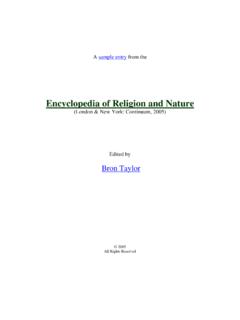Transcription of The Biomedical Bubble - media.nesta.org.uk
1 The Biomedical BubbleRichard Jones and James WilsdonJuly 2018 Why UK research and innovation needs a greater diversity of priorities, politics, places and people About NestaNesta is a global innovation foundation. We back new ideas to tackle the big challenges of our use our knowledge, networks, funding and skills - working in partnership with others, including governments, businesses and charities. We are a UK charity but work all over the world, supported by a financial find out more visit you d like this publication in an alternative format such as Braille, large print or audio, please contact us at: the authorsThis paper started life as a conversation with Geoff Mulgan, and we are hugely grateful to Geoff and his Nesta colleagues particularly Kirsten Bound, Halima Khan and John Loder for their encouragement and advice, which has strengthened and sharpened our argument.
2 Thanks also to those who have provided helpful input or commented on earlier drafts, including Andrew Baker, Athene Donald, Paul Martin, Jasper Montana, Jon Nicholl, David Price, Shamit Saggar, Jack Scannell and Jack Stilgoe. At the University of Sheffield, Jenn Chubb and Jon Griffiths provided valuable research support. At Nesta, Cath Sleeman and Helen Durham lent us their skills in data visualisation and design. Any errors or omissions remain our own. Our analysis is inevitably influenced we hope not unduly so by our own perspectives as a physicist and social scientist, based in the north of England. But it draws on wider strands of our work over recent years: on research policy and funding; industrial strategy and innovation; productivity and public engagement.
3 Above all, it is motivated by our abiding conviction that the ultimate purpose of research is for the widest benefit of society, and our hope is to provoke a richer debate about how best that is effected. Richard Jones and James Wilsdon, July 2018 Richard Jones (@RichardALJones) is Professor of Physics at the University of Sheffield, and was a member of the Council of the Engineering and Physical Sciences Research Council (EPSRC) from 2013 to 2018. From 2009 to 2016 he was Pro-Vice Chancellor for Research and Innovation at the University of Sheffield, where he helped to develop the Sheffield City Region Advanced Manufacturing Innovation District. He was elected a Fellow of the Royal Society in 2006, and is an Associate Fellow of the Sheffield Political Economy Research Institute (SPERI).
4 He is an experimental soft matter physicist, and in addition to his work as an experimental scientist has written extensively on science, innovation, productivity and economic policy. He is the author of over 160 research papers, and three books including Soft Machines: nanotechnology and life (2004). He is a member of the Industrial Strategy Commission, which published a major report in November 2017. James Wilsdon (@jameswilsdon) is Professor of Research Policy and Director of Research and Innovation in the Faculty of Social Sciences at the University of Sheffield. He is also vice-chair of the International Network for Government Science Advice (INGSA). From 2013 to 2017, he chaired the UK s Campaign for Social Science, and from 2014 to 2015, he led an independent government review of the role of metrics in the UK research system, published as The Metric Tide.
5 Previously, he worked at the universities of Sussex and Lancaster, and as Director of Science Policy at the Royal Society. He is co-editor of the Guardian s Political Science blog on research and innovation policy. In 2015, he was elected a Fellow of the Academy of Social Sciences, and he now chairs its Policy Working Biomedical BubbleWhy UK research and innovation needs a greater diversity of priorities, politics, places and people Foreword 4 The Biomedical Bubble - 5 a summary The long boom of UK 9 Biomedical science The age of the genome 9 Unravelling the secrets of the cell 10 The golden years of the UK s 10 pharmaceutical industry The health dividend 11 Return on past investments 13 people power: medical charities and 14 public support for research Priorities.
6 Doubling down 15 on Biomedical science Changing priorities for UK research 15 The UK health research landscape 17 Mismatches between disease burden 19 and research effort The right research for population 21 health outcomes The right research for industrial 22 strategies What else matters, apart from health? 25 Politics: how Biomedical 26 models shape policy thinking Big pharma now - a broken business 26 model? Whatever happened to the UK s 30 biotechnology revolution? Biomedical science and its discontents 33 A Bubble at bursting point? 37 Places: how Biomedical 38 science exacerbates inequality The gilding of the golden triangle 40 The benefits of clustering 41 How many clusters can we have?
7 42 Where the ill people are 43 The revolt against the elites 45 people : who sets the 46 agendas for Biomedical research? Gene editing, Asilomar and epistemic 46 bubbles Experiments in engagement 47 Diversity dividends and collective 49 intelligence Beyond the Bubble : 51 the opportunity of UKRI The return of industrial strategy 52 An industrial strategy for the 54 pharmaceutical, biotech and medtech sectors The innovation we need for health 56 and social care Pushing for per cent R&D intensity - 58 what kind of research and where? Getting serious about place and 62 regional balance Engagement and experimentation 63 Measuring success through 65 meta-researchEndnotes 67 July 2018142536 The Biomedical Bubble : Why UK research and innovation needs a greater diversity of priorities, politics, places and people 4 ForewordKirsten Bound, Executive Director of Research, Analysis and Policy at NestaThe UK is on the cusp of what we hope will be the greatest surge in public investment in science and innovation for a generation.
8 And the launch of UK Research and Innovation (UKRI) brings a radical reorganisation of its institutions. This presents a huge opportunity to do things better, and not just to remake the existing system on a grander want to see a UK research and innovation system which is not only more productive and dynamic, securing long-term economic growth and competitiveness, but also fairly geared towards addressing the priorities of the people within have been important discussions about the need to shape the direction as well as speed of economic growth through investments in science and innovation - for instance about mission driven, transformative and inclusive innovation policy. Yet we are still early in implementing the bold shifts in policy thinking and practical organisation required, and in understanding how to deal with the complex Biomedical Bubble is the ideal lens through which to consider these difficult balances.
9 The authors show it is a field the UK excels in, and one that has benefited disproportionately from public funding as a result. But as funding as grown, the productivity of that investment has declined. The authors question not only a broken R&D model, but an endemic bias in public support for R&D which still hugely prioritises manufacturing over services, decades after the UK economy shifted. They also question a system in which the health benefits of research and innovation spending do not spread in a way that is fast or fair half of all health issues are rooted in environmental and behavioural factors, yet too little of the R&D budget for health is invested in exploring these more authors are not arguing against vital medical research or discovery-led biological research.
10 Far from it. They are champions of UK science investment. But they are arguing for a review and reassessment of spending priorities, and a more sophisticated way to get the balance right in the far this concentration on Biomedical life sciences has not been challenged or debated. We believe that there needs to be a proper debate about whether or not this is the right balance. For the first time, this report sets out the evidence, facts and analysis we need to have that report raises important and challenging questions, and also offers practical ways to capitalise on the opportunity of UKRI for the UK s future. We look forward to the ideas and conversations it generates, and to working with UKRI and the wider community to shape an innovation system that powers a thriving future economy and Biomedical Bubble : Why UK research and innovation needs a greater diversity of priorities, politics, places and people 5 The Biomedical Bubble - a summary As a government, we have set the goal of research and development investment reaching per cent of GDP by 2027 - more than ever before.






